InterviewSolution
This section includes InterviewSolutions, each offering curated multiple-choice questions to sharpen your knowledge and support exam preparation. Choose a topic below to get started.
| 1551. |
Kanham Neeraj and Asha were partners in a fiem. They admitted Raghav their Iandlord as a partner the the firm. Raghav brings suffcient amount of capital and good will premium for his share in the profits. Raghav had given a long of Rs. 1,00,000 @10% p.a. interest to the partnership firm before on lone should be paid @6% p.a. Is he right in doing so? Give reason in support of your answer. |
|
Answer» SOLUTION :No, accountant is not right in doing so. Reason: RAGHAV had given a loan of Rs.1,00,00 @`10%` p.a. interest to the partnership firm before he become the partner and had been agreed to be PAID interest at that rate. |
|
| 1552. |
KanikaandGautamarepartnersdoing a dry claaningbusinessin luknowsharingprofits in theratio2:1withcapitalsRs. 5,00,000andRS. 4,00,000 respectivelykanikawithdrew thefollowingamounts duringtheyear to paythehostalexpensesof herson :{:("1stApril",Rs."10,000"),("1st june","Rs.9,000"),("1st november","Rs.14,000"),("1st December","Rs.5,000"):}gauatma withderw Rs. 15,000on thefirstdayof Aprildayapril,julyOctoberandjanuary to pay rentfor theaccommodationof hisfamily,He aslopaid RS. 20,000 permonth asrentfor theofficeof partnershipwhichwasin anearbyshoppingcomplex . calculate intereston drawing 26% p.a |
|
Answer» |
|
| 1553. |
Kapil Ltd. improves its Current Ratio to 2:1, and Quick Ratio to 1:1,in your opinion can it be rated as better company than Kamal Ltd? |
| Answer» Solution :If KAPIL LTD. IMPROVES its Current Ratio and Quick Ratio but still Inventory (Stock) Turnover Ratio is low and similarly Fixed ASSETS Turnover Ratio, Current Assets Turnover Ratio and TOTAL Assets Turnover Ratio are also low, it indicates over-investment in stocks and inefficient use of assets. | |
| 1554. |
Kajal, Neerav and Alsha are partners in a firm sharing profits in the ratio of 3:2: 1 They decided to admit Rajan, their landlrd as a partner in the firm. Rajan brought suffcient amount of capital and his share of goodwill premium. The accountant of the firm passed the entry of rent paid for the building to rajan in 'Profit and Loss Appropriation Account' Is he correct in doing so? Give reason is support of your answer. |
|
Answer» Solution :No, ACCOUNTANT of the is not CORRECT in doing so. Reason: Because rent PAID is a charge against the profit so it should be debited to profit and Loss ACCOUNT. |
|
| 1555. |
Kamaland kapilare partnershavingfixedcapitalsof Rs. 5,00,000eachas on31stMarch, 2018Kamalintroducedfurthercapitalof Rs. 1,00,000on 1st October, 2018wheredrew Rs,. 1,00,000 on1stOctober, 2018outof capital . intereston capitalistoallowed@ 10%p. a the firmearnednetprofitof Rs. 6,00,000for theended31st March ,2019 passthejournal entryforinterest on capitaland prepareprofitand LossappropriationAccount |
|
Answer» CR. KAMAL 'sCurrectA/CBY RS. 55,000andkapil's CURRECT A/c by Rs. 45,000 2.shareof profitkamal=Rs. 2,50,000and kapil-Rs. 2,50,000 |
|
| 1556. |
Kalpana and Kanika were partners in a firm sharing profits in the ratio of 3:2. On 1st April, 2019, they admitted Karuna as a new partner for 1/5th share in the profits of the firm. The Balance Sheet of Kalpana and Kanika as on 1st April, 2019 was as follows: It was agreed that, (a) the value of Land and Building will be appreciated by 20%. (b) the value of plant be increased byRs 60,000. (c) Karuna will bringRs 80,000 for her share of goodwill premium. (d) the liabilities of Workmen's Compensation Fund were determined atRs 60,000. (e) Karuna will bring in cash as capital to the extent of 1/5th share of the total capital of the new firm. Prepare Revaluation Account, Partner's Capital Accounts and Balance Sheet of the new firm. |
|
Answer» 2. Calculation of Karuna's Capital: Combined capital of Kalpana and Kanika (after all adjustments) for 4/5 share =Rs6,49,200+Rs3,22,800 =Rs 9,72,000. It means , FIRM's Total Capital `=Rs 9,72,000 xx 5//4 =Rs 12,15,000,` Karuna's Share of Capital `=Rs12,15,000 xx 1//5 =Rs2,43,000.` |
|
| 1557. |
Kabir and Farid are partners sharing profits and losses in the ratio of 7:3. Kabir surrenders 2/10th from his share and Farid surrender 1/10th from his share in favour of Jyoti, a new partner. Calculate new profit-sharing ratio and sacrificing ratio. |
| Answer» SOLUTION :NEW Profit-sharing RATIO `=5:2:3,` SACRIFICING Ratio `=2:1.` | |
| 1558. |
K Limited has been registered with an authorised capital of Rs. 20,00,000 divided into 20,000 shares of Rs. 100 each, of which 10,000 shares were offered for public subscription at a premium of Rs. 5 per share, payable as under : {:(,"Rs."),("On application",30),("On allotment","25 (including premium)"),("On first call",20),("On final cal",30):} Applications were received for 18,000 shares, of which applications for 3,000 shares were rejected outright, the rest the applications were allotted 10,000 shares on pro-rata basis. Excess application money was transferred to allotment. All the moneys were duly received except from Sundar, holder of 200 shares, who failed to pay allotment and first call money. His shares were later forfeited made. Pass necessary Cash Book and Journal entries in the books of K Limited. |
|
Answer» SOLUTION :Amount received on allotment RS. 98,000, Amount transferred to CAPITAL Reserve Rs. 7,000, Cash at Bank Rs. 7,56,000. Note : Secureties Premium Reserve Account has been debited in the entry of forfeiture because it is assumed that the ENTIRE excess application money is UTILISED for share capital. |
|
| 1559. |
Joy Ltd. issued 1,00,000 equity shares of Rs. 10 each. The amount was payable as follows : {:("On application","Rs. 3 per share"),("On allotment","Rs. 4 per share"),("On 1st and final call","Balance"):} Applications for 95,000 shares were received and shares were allotted to all the applicants. Sonam to whom 500 shares were allotted failed to pay allotment money and Gautam paid his entire amount due including the amount due on first and final call on the 750 shares allotted to him along with allotment. What was the amount received on allotment ? |
| Answer» SOLUTION :RS. 3,80,250. | |
| 1560. |
Joy Ltd. invited applications for issuing 20,000 equity shares of Rs. 10 each at per. The amount was payable as follows: {:("On Application ",,-,,"Rs. 3 per share"),("On Allotment",,-,,"Rs. 4 per share"),("On First Call and Final Call",,-,,"Balance amount"):} The issue was oversubscribed by three times. Applications for 20% shares were rejected and the money was refunded. Allotment was made to the remaining applicants as follows: {:("Category",,"No.of Shares Applied",,"No. of Shares Allotted"),("I",,"30,000",,"15,000"),("II",,"18,000",,"5,000"):} Excess money receivedwith applications was adjusted towards sums due on allotment.Money in excess to sums due on allotment was adjusted towards sums due on first andfinal call and any money in excess to sums due on first and final call was refunded. Kavi, a shareholder who had applied for 600 shares, failed to pay the remaining allotment money andhis shares were immediately forfeited. Kavi belonged to Category I. Afterwards the first and final call was made. Gupta, who had applied for 400 shares, failed to pay the first andfinal call. Gupta also belonged to Category I. Shares of Gupta were also forfeited after the first and final call. The forfeited shares were reissued at Rs. 12 per share fully paid -up. Pass necessary Journal entries for the above transactions in the books of Joy Ltd. |
Answer» Solution :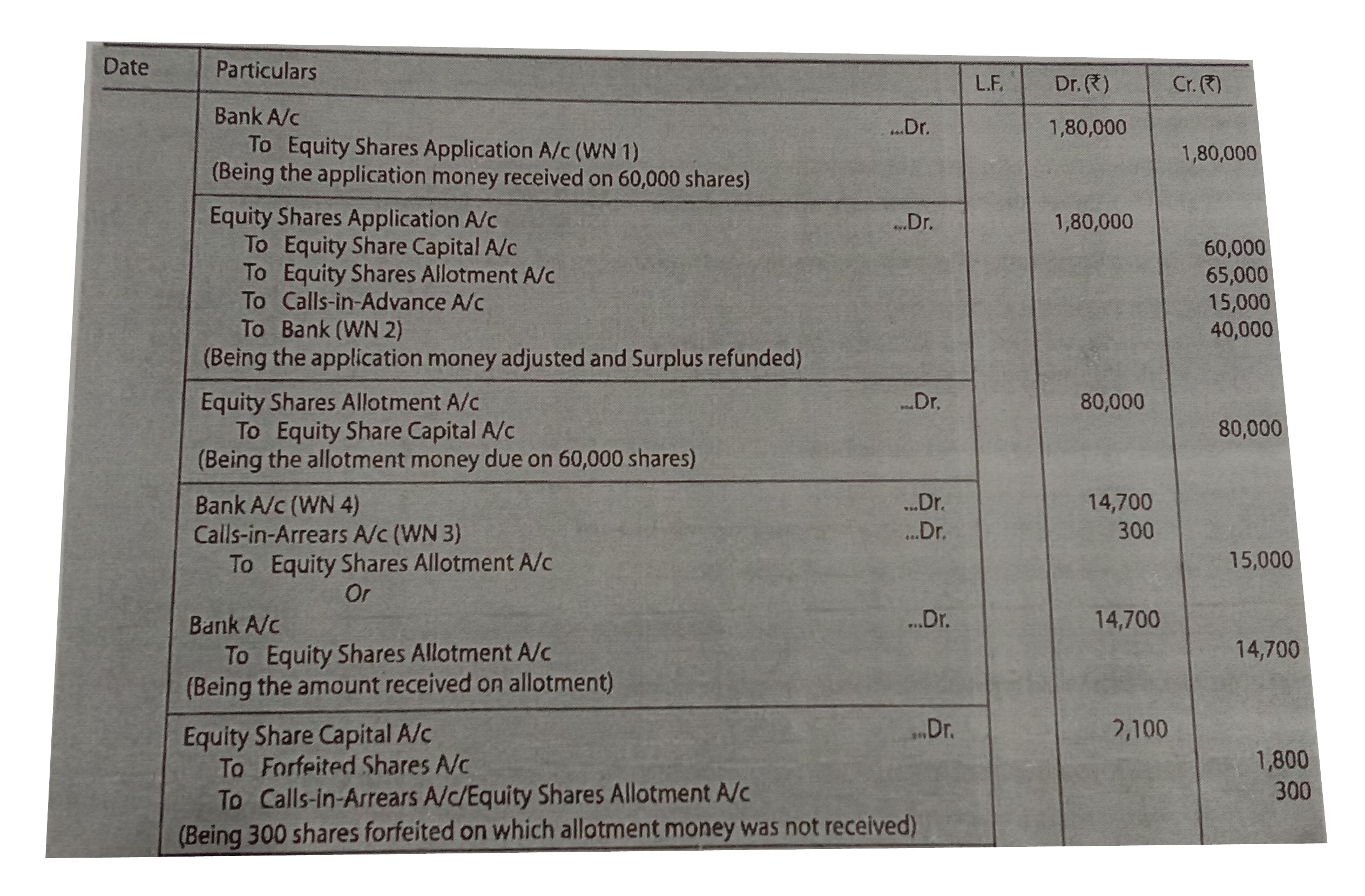 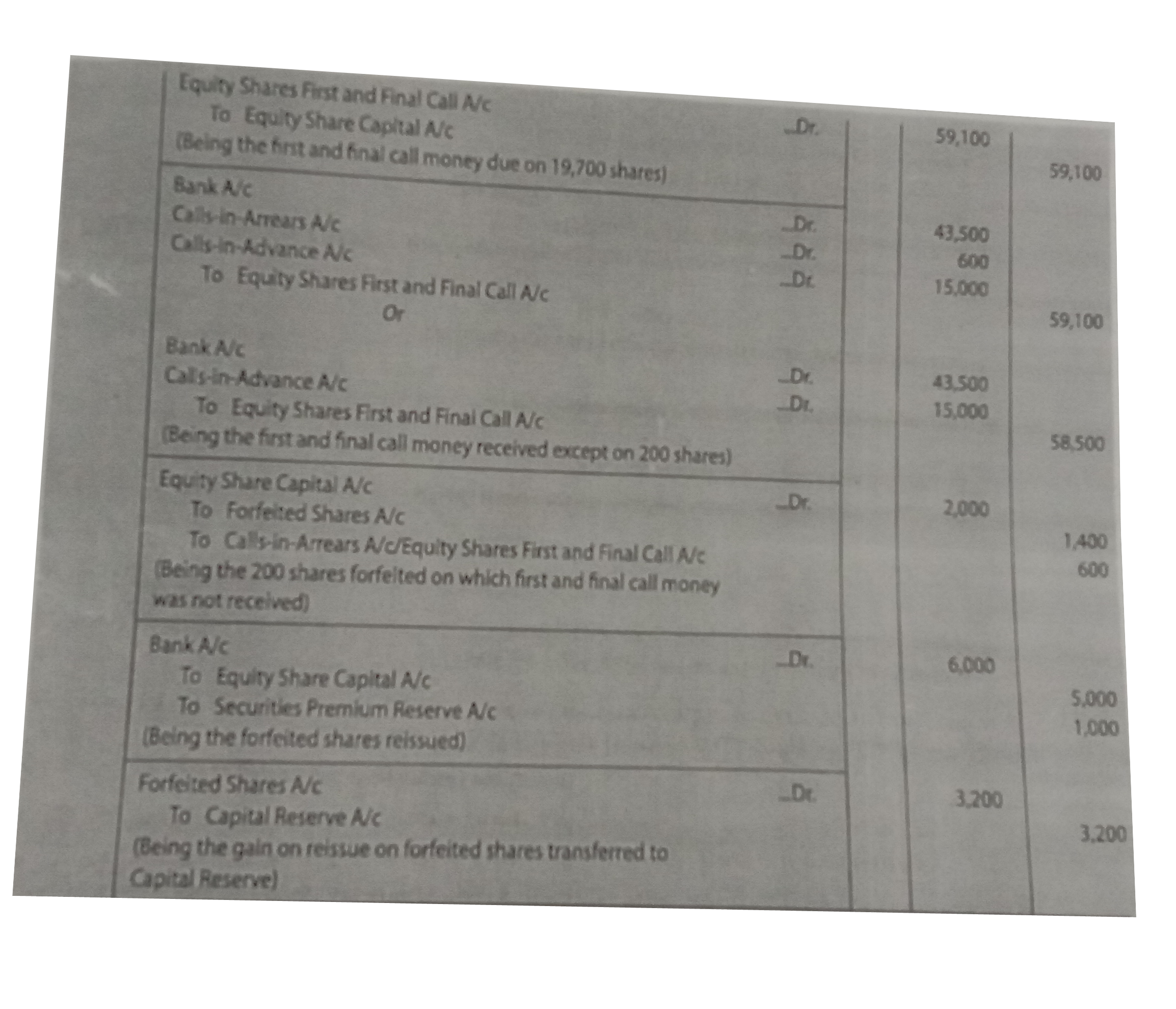 Working Notes: 1. Number of Shares applied for by the publicandpro rata ALLOTMENT made = 30,000 + 18,000 = 48,000 THEREFORE, Total Number of Shares applied for by the public `=48,8000 xx(100)/(100-20)=60,000" shares".` 2. Table Showing Adjustment of Excess APPLICATION Money  *Category III `to` Allotment = 60,000(Shares Applied) - 48,000 (Shares Alloted) = 12,000 shares. 3. Calculation of allotment money due but not paid by Kavi: Number of shares applied in Category I = 30,000 Number of shares allotted in Category I = 15,000 Ratio of shares applied and allotted = 30,000: 15,000 = 2 : 1 Shares allotted to Kavi= 600`xx` 1/2 = 300 shares Excess application money paid by Kavi towards shares allotment = `(600xx"Rs."3)-(300xx"Rs."3)` = Rs. 900 `{:(,,Rs.),("Allotment money due from Kavi(300"xx"Rs.4)",,"1,200"),("Less: Excess application money adjusted towards allotment:",," "900),(,,bar(ul(ul(" "300)))):}` 4. Calculation of allotment money received later: `{:(,,Rs.),("Shares Allotment money due (20,000"xx"Rs.4)",,"80,000"),("Less: Excess application money adjusted on allotment (WN2)",,"65,000"),(,,ul(15,000)),("Less: Allotment money not paid by Kavi",,""300),(,,bar(ul(ul(14,700)))):}` 5. Shares allotted to Gupta = 400 `xx 1//2` = 200 shares Amount not paid by Gupta on Call = 200 `xx` Rs. 3 = Rs. 600. |
|
| 1561. |
John Ibrahm, a partner in Modern Tours and Travels withdrew money during the year ending March 31, 2017 from his capital account, for his personal use. Calculate interest in drawings in each of the following alternative situations, if rate of interest is 9 per cent per annum. (a) If he withdrew Rs. 3,000 per month at the beginning of the month. (b) If an amount of Rs. 3,000 per month was withdrawn by him at the end of each month. (c) If the amounts withdrawn were : Rs. 12,000 onJune 01, 2016, Rs. 8,000, on August 31, 2016, Rs. 3,000, on September 30, 2016, Rs. 7,000, on November 30, 2016, and Rs. 6,000 on January 31, 2017. |
|
Answer» SOLUTION :(a) As a fixed amount of Rs. 3,000 PER MONTH is withdrawn at the beginning of the month, interest on drawings will be calculated for an average period of `6½`MONTHS. Interest on drawings`=Rs.(36,000xx9xx13xx1)/(100xx2xx12)=Rs.1,755` (b) As the fixed amount of Rs. 3,000 per month is withdrawn at the END of each month, interest on drawings will be calculated for an average period of5 ` 1//2` months. `Rs.(36,000xx9xx11xx1)/(100xx2xx12)=Rs. 1,485` 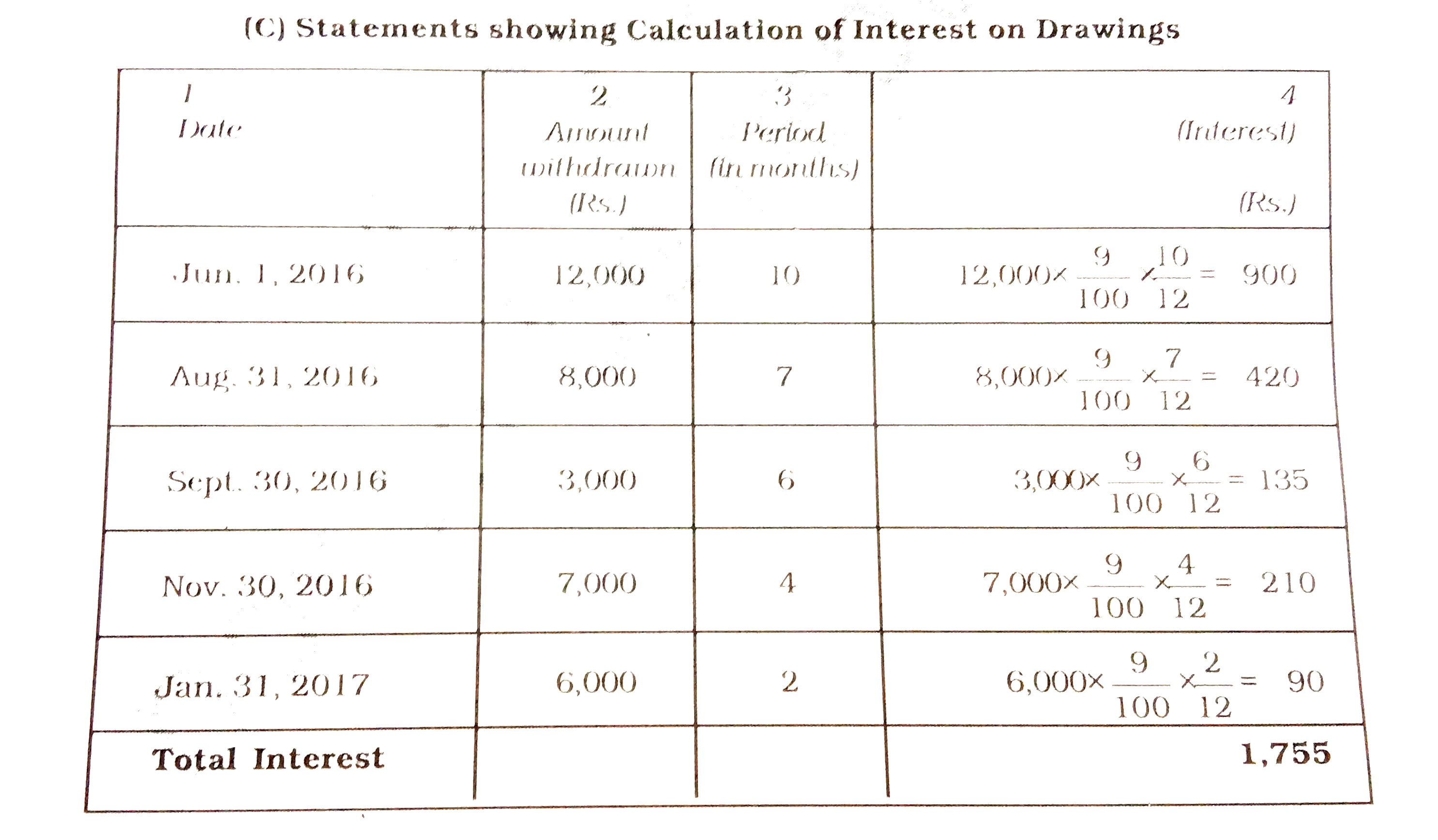
|
|
| 1562. |
John and Mathew share profits and losses in the ratio of 3:2. They admit Mohanty into their firm to 1/6 share in profits. John personally guaranteed that Mohanty’s share of profit, after charging interest on capital @ 10 per cent per annum would not be less than Rs. 30,000 in any year. The capital provided was as follows: John Rs. 2,50,000, Mathew Rs. 2,00,000 and Mohanty Rs. 1,50,000. The profit for the year ending March 31,2015 amounted to Rs. 1,50,000 before providing interest on capital. Show the Profit & Loss Appropriation Account if new profit sharing ratio is 3:2:1. |
Answer» SOLUTION :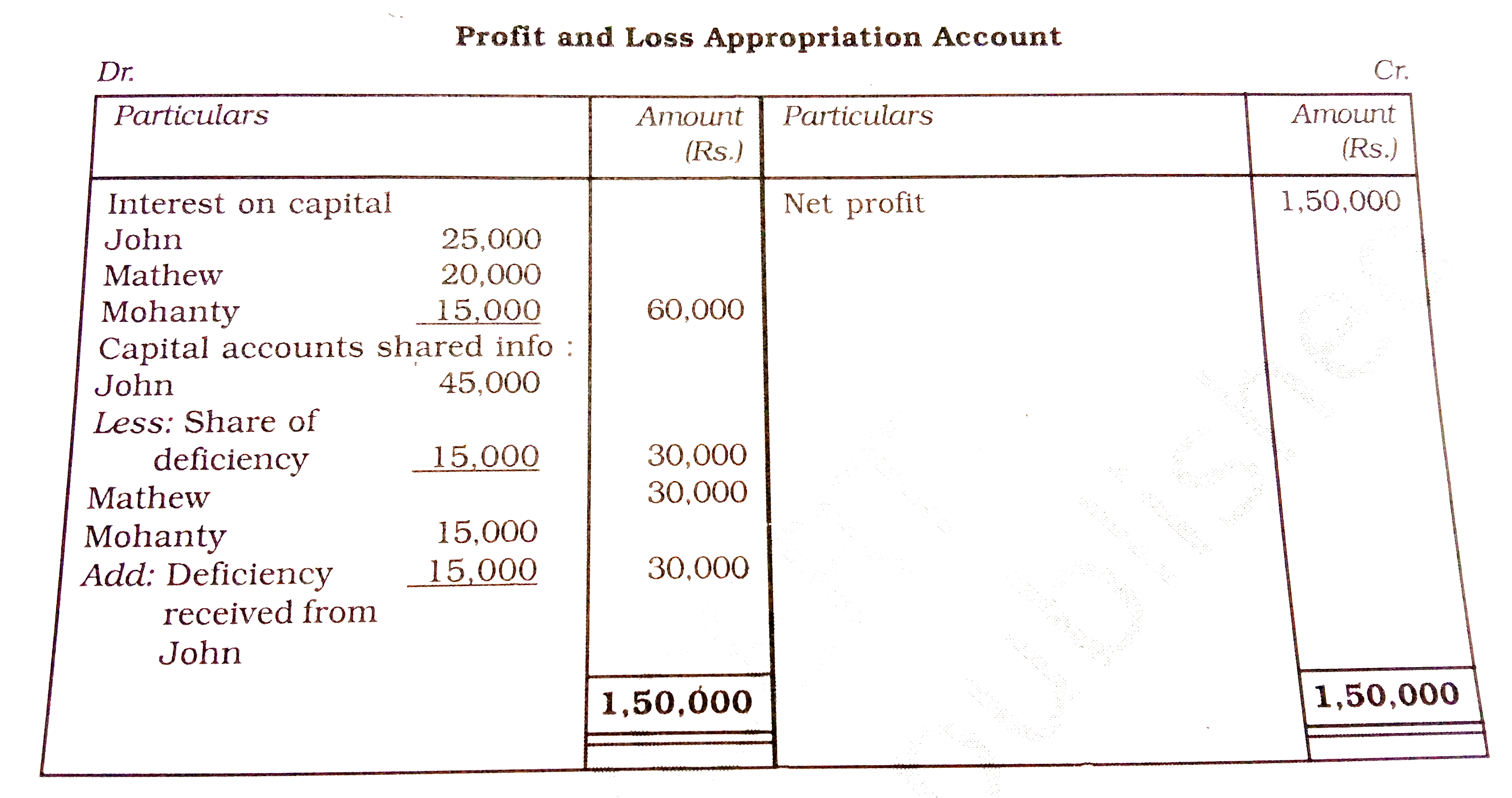
|
|
| 1563. |
JJK Ltd., invited applications for issuing 50,000 equity shares of Rs. 10 each at par. The amount was payable as follows : {:("On Application",:,"Rs. 2 per share"),("On Allotment",:,"Rs. 4 per share"),("On First and Final Call",:,"Balance Amount"):} The issue was oversubscribed three times. Applications for 30% shares wererejected and money refunded Allotment was made to the remaining applicants as follows : {:("Category","No. of Shares Applied","No. of Shares Allotted"),("I","80,000","40,000"),("II","25,000","10,000"):} Excess money paid by the applicants who were allotted shares was adjusted towards the sums due on allotment. Deepak, a shareholder belonging to Category I, who had applied for 1,000 shares, failed to pay the allotment money. Raju, a shareholder holding 100 shares, also failed to pay the allotment money. Raju belonged to Category II. Shares of both Deepk and Raju were forfeited immediately after allotment. Afterwards, first and final call was made and was duly paid up. Pass necessary journal entries for the above transactions in the books of the company. |
|
Answer» Solution :Net Amount received on allotment Rs. 88,900, Amount received on FIRST & final call Rs. 1,97,600, Capital Reserve Rs. 2,500. Hint : (i) Applications received for 1,50,000 shares. (ii) `{:(,,"Rs."),("Total amount due on allotment",,"2,00,000"),("LESS :Excess received on application",,UL("1,10,000")),(,,"90,000"),("Less :Not received from Deepak","1,000",),("Not received from RAJU",ul(100),ul("1,100")),(,,ul(ul("88,900"))):}` |
|
| 1564. |
Jeevan Dhara Ltd., invited applications for issuing 1,20,000 equity shares of Rs. 10 each at a premium of Rs. 2 per share. The amount was payable as follows : {:("On Application",-,"Rs. 2 per share"),("On Allotment",-,"Rs. 5 per share (including premium)"),("On first and final call",-,"balance"):} Applications for 1,50,000 shares were received. Shares were allotted to all the applicants on pro-rata basis. Excess money received on applications was adjusted towards sums due on allotment. All calls were made. Manu who had applied for 3,000 shares failed to pay the amount due on allotment and first and final call. Madhur who was allotted 2,400 shares failed to pay the first and final call. Shares of both Manu and Madhur were forfeited. The forfeited shares were rer-issued at Rs. 9 per share as fully paid up. Pass necessary journal entries for the above transactions in the books of jeevan Dhara Ltd. |
|
Answer» Solution :Amount received on allotment Rs. 5,29,200, Capital RESERVE Rs. 13,200. HINT : SECURITY Premium due from MANU Rs. 4,800 will be debited in the ENTRY for forfeiture. |
|
| 1565. |
Jayant, Kartik and Leena were partners in a fierm sharing profits and losses in the ratio of 5:2:3. Kartik died and Jayant and Leena decided to continue the business. Their gaining ratio was 2:3. Calculate the new profit-sharing ratio of Jayant and Leena. |
|
Answer» Solution :OLD profit-sharing ratio of JAYANT, Kartik and Leena `=5:2:3` On kartik's DEATH: Jayant's Gain `=2//10xx2//5=4//50` Leena's Gain `=2//10xx3//5=6//50` NEW Share = Old share+ GAINED Share Jayant's New Share `=5/10+4/50=(25+4)/(50)=29/50` Leena's Now Share `=3/10+6/50=(15+6)/(50)=21/50` Thus, New Profit-sharing Ratio of Jayant and Leena `=29//50: 21//50 or 29//21.` |
|
| 1566. |
Jaya Ltd., issued 60,000 shares of Rs. 10 each at a premium of Rs. 2 per share payable as Rs. 3 on Application, Rs. 5 (Including premium) on Allotment and the balance on first and final call. Applications were recived for 82,000 shares. The Directors resolved to allot as follows : {:((A),"Applicants of 30,000 shares","20,000 shares"),((B),"Applicants of 50,000 shares","40,000 shares"),((C ),"Applicants of 2,000 shares","Nil"):} Ramesh who had applied for 900 shares in catagory (A), and Suresh who was allotted 600 shares in category (B) failed to pay the allotment money. Calculate the amount received on Allotment. |
| Answer» SOLUTION :AMOUNT RECEIVED on ALLOTMENT RS. 2,35,350. | |
| 1567. |
Jaya, Kirti, Ekta and Shewata are partners in a firm sharing profits and losses in the ratio of 2 : 1 : 2: 1 .On Jaya's retirement, the goodwill of the firm is valued at Rs. 36,000. Kirti, Ekta and Shweta decided to share future profits equally. Record the necessary journal entry for the treatment of goodwill without opening 'Goodwill Account'. |
Answer» Solution : Working Notes 1. Jaya's SHARE of GOODWILL `=Rs. 36,000xx(2)/(6)=Rs.12,000` 2.Calculation of Gaining Ratio Gaining Share = New Share - Old Share Kirti's GAIN`=(1)/(3)-(1)/(6)=(2-1)/(6)=(1)/(6)` Ekta's Gain = `=(1)/(3)-(2)/(6)=(2-2)/(6)=(0)/(6)`(Neither Gain nor Sacrifice) Shewata's Gain `=(1)/(3)-(1)/(6)=(2-1)/(6)=(1)/(6)` Hence, Gaining ratio between Kirti and Shewata `(1)/(6):(1)/(6)=1:1` |
|
| 1568. |
Janta Ltd., had an authorized capital of 2,00,000 equity shares of Rs. 10 each. The company offered to the public for subscription 1,00,000 shares. Applications were received for 97,000 shares. The amount payable on application was Rs. 2 per share, Rs. 4 was payable each on allotment and first and final call. A shareholder holding 600 shares failed to pay the allotment money. His shares were forfeited. The company did not make first and final call.Present the share capital in the Balance Sheet of the company as per Schedule III of the Companies Act, 2013. Also prepare Notes to accounts. |
| Answer» SOLUTION :SUBSCRIBED but not fully PAID Capital : Rs. 5,78,400 + Rs. 1,200 = Rs. 5,79,600. | |
| 1569. |
Jay Ltd. issued a prospectus inviting applications for 1,00,000 shares of Rs. 10 each. These shares were issued at par on the following terms : On application Rs. 2.50, on allotment Rs. 2.50, on first call Rs. 3 and on final call the balance. Applications were received for 1,35,000 shares. Allotments were made on the following basis : (i) To applicants for 25,000 shares - in full, (ii) To applicants for 60,000 shares - 45,000 shares To applicants for 50,000 shares - 30,000 shares All excess amount paid on applicantion is to be adjusted against amount due on allotment. The shares were fully called and paid-up except the amount of allotment, first and final call not paid by those who applied for 4,000 shares of the group applying for 50,000 shares. All the shares on which calls were not paid were forfeited by the Board of Directors. 1,800 forfeited shares were re-issued as fully paid on receipt of Rs. 9 per share. Prepare Cash Book and Journal entries to record the above. |
| Answer» Solution :Cash RECEIVED on ALLOTMENT Rs. 1,60,500, Bank Balance Rs. 10,02,200, Capital RESERVE Rs. 5,700. | |
| 1570. |
Janta Ltd. had an authorised capital of 2,00,000 equity shares of Rs. 10 each. The company offered to the public for subscription 1,00,000 shares. Applications were received for 97,000 shares. Theamount was payable as followes: on application Rs. 2 per share, Rs. 4 payable each on allotment and first and final call. A shareholding 600 shares failed to pay theallotment money. His shares were forfeited. The company did not make thefirst and final call. Present the share capital in the BalanceSheet of the company as per Schedule III of the Companies Act, 2013. Also prepare Notes to Accounts. |
Answer» SOLUTION :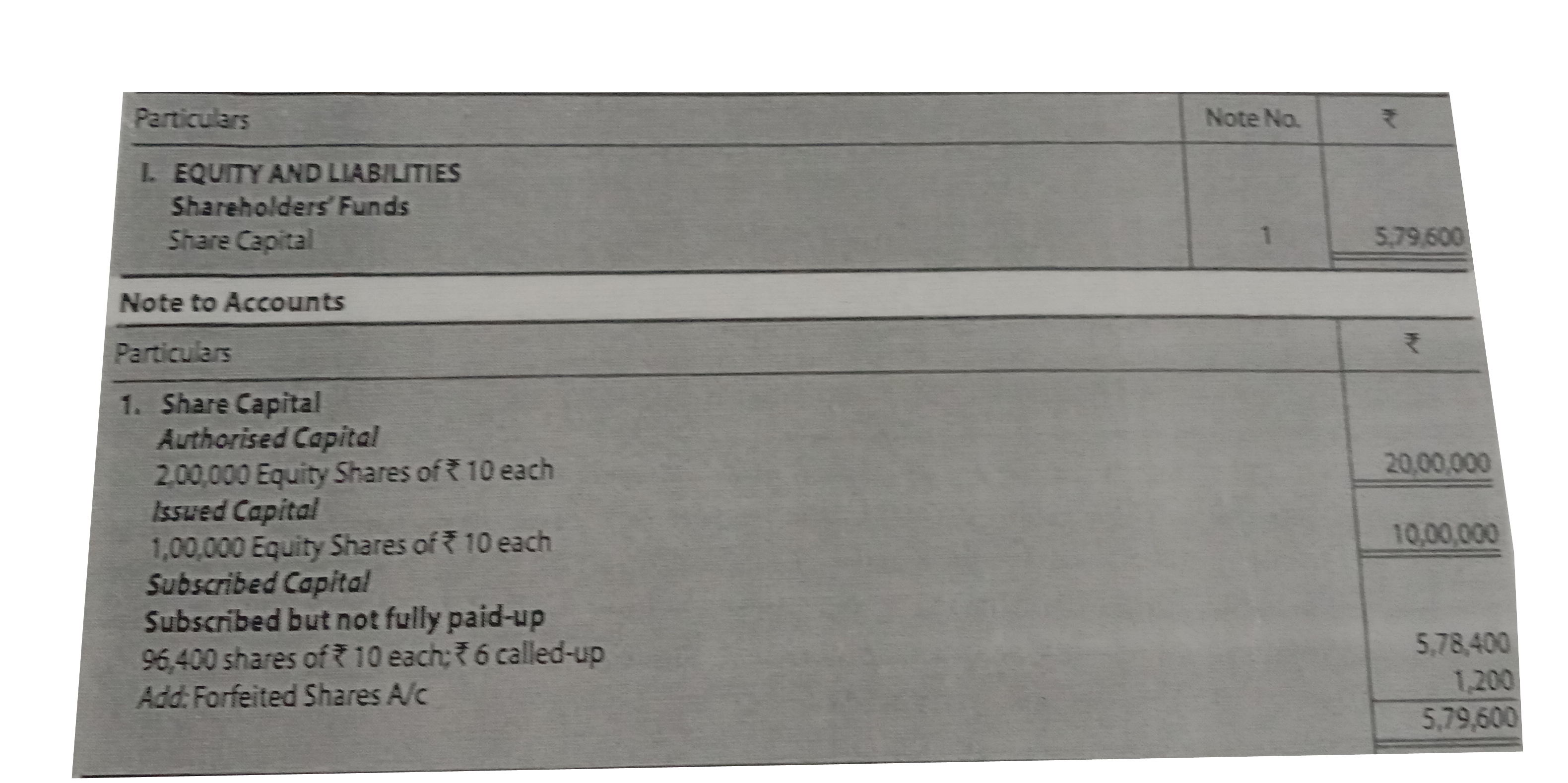
|
|
| 1571. |
Jai and Raj are partnerssharing profits in theratio of 3:2 . Witheffect from1st April, 2019, theydecided to share profits equally . Goodwill apperared in the books at ₹25,000. As on 1st April, 2019, it will valued at ₹1,00,000. Theydecided to carrygoodwill in the books of the firm.Passthe Journal entrygivingeffect to theabove. |
|
Answer» |
|
| 1572. |
Jan Dhan Bank, an All India Financial Institution , had 10,000 , 12% debenturesof .Rs 100 each , outstanding as at 31st March, 2017. These debentureswere due for redemption on 30th June, 2018, Pass necessary Journal Entries for redemption of debentures . Also state the amount of Debenture Redemption Reserve to be createdfor the purpose of redemption . |
Answer» Solution : Note : According to Section 71 (4) of the CompaniesRules , 2014 , an All India FINANCIAL INSTITUTION is not required to create Debenture Redemption RESERVE. |
|
| 1573. |
Jag, Pravesh and Chander are partners in a firm sharing profits in the ratio of 5:3:2. respectively. Firm closes its accounts on 31st March every year. Jag dies on 30th September 2012. There was a balance of 47,000 in Jag's Capital Account in the beginning of the year. In the event of death of any partner, the Partnership Deed provides for the following: (i) Interest on capital will be calculated at the rate of 12% p.a. (ii) The deceased partner's representive will be paid Rs 16,000 for his share of goodwill. (iii) His share of Reserve Fund which is Rs 50,000, shall be paid to his executor. (iv) His shar of profit till the date of death will be calculated on the basis of sales. It is also specified that the sales during the year 2011-12 were Rs 10,00,000. The sales from 1st April, 2012 to 30th September, 2012 were Rs 2,00,000. The profit of the firm for the year ending 31st March, 2012 was Rs 1,00,000. Prepare Jag's Capital Account to be presented to his representative. |
Answer» Solution : Notes: 1. JOG's SHARE of GOODWILL is contributed by Pravesh and CHANDER in the gaining ratio, i.e., `3:2.` 2. Jag's Share of Profit till the DATE of death: (i) % of profit on sales `=("Profit")/("Sales")xx100=(Rs1,00,000)/(Rs10,00,00)xx10=10%.` (ii) Profit on sale (1 st April, 2012 to 30th Septembe, 2012) `=Rs2,00,000xx10//100=Rs20,000.` (iii) Jay's share of profit `=Rs20,000xx5//10=Rs10,000.` |
|
| 1574. |
It is wrong to say that the liquidity of a business firm is meaured by its ability to satisfy its long term obligaitons as they become due .The liquidity of a business firm is marued byits ability to satisfy its short term obligations i.e current Liabilities. |
| Answer» | |
| 1575. |
Issued 5,000, 12% debentures of .Rs 100 each at a discount of 2 %, redeemable at a premium of 5 % . In such case : |
|
Answer» Loss on Issue will be Credited by .Rs 10, 000. |
|
| 1576. |
(Issue of Debentures as Collateral Security). X Ltd. secured a loan of Rs. 8,00,000 from the Bank of Baroda by issuing 10,000, 9% Debentures of Rs. 100 each as a collateral security. How will you show the issue of such debentures in the Balance Sheet? |
Answer» SOLUTION :FIRST METHOD (When ENTRY is not PASSED):  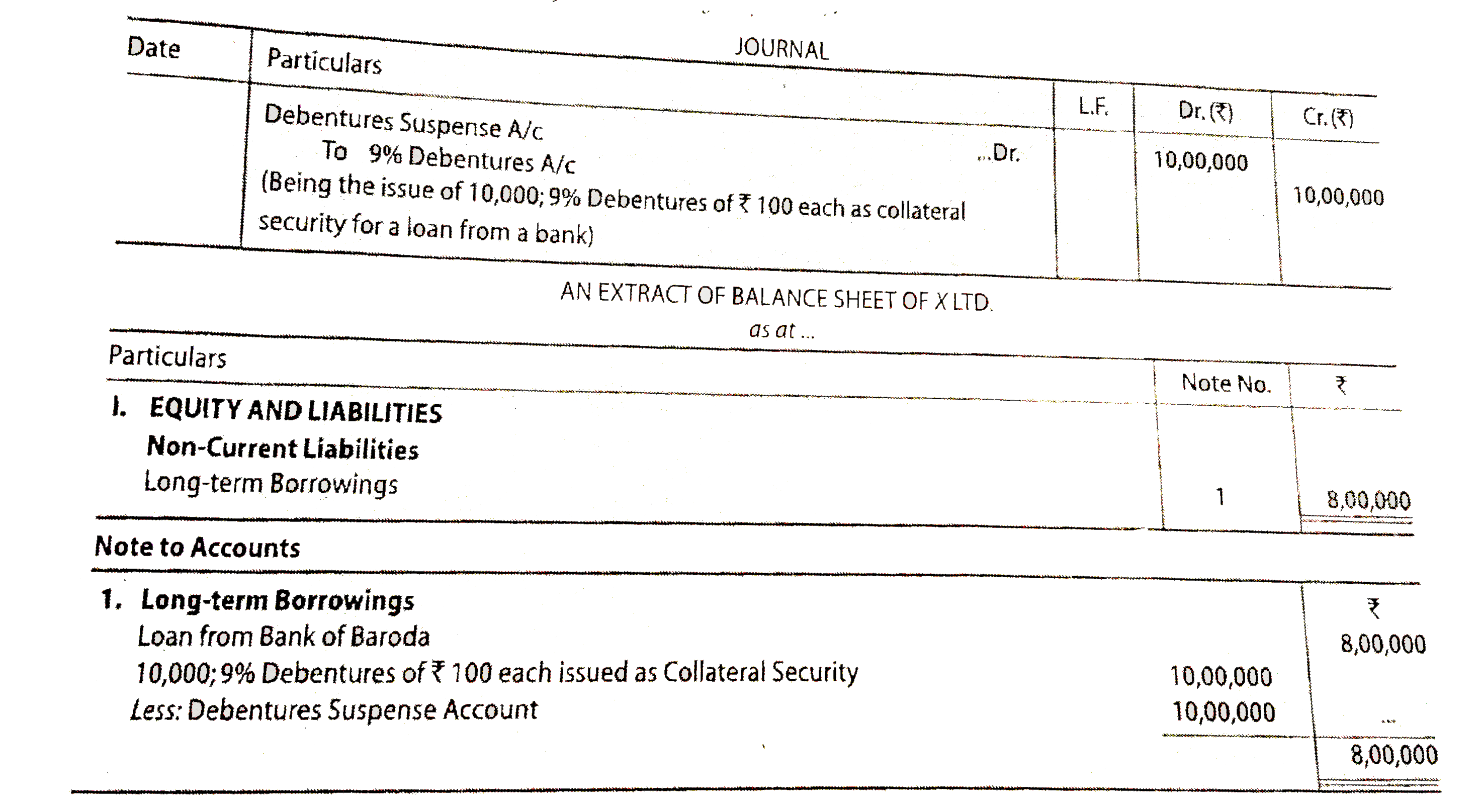
|
|
| 1577. |
Issued 4,000 , 12% debentures of .Rs 100 each at a premium of 4%, redeemable at a premium of 10%. In such case: |
|
Answer» LOSS on ISSUE will be DEBITED by .Rs 24,000 |
|
| 1578. |
Is the debit balance of Receipts and Payments Account of the Not-for-Profit Organisation as asset or expense ? |
|
Answer» |
|
| 1579. |
Is Subscription received in advance an income or a liability? |
|
Answer» |
|
| 1580. |
Is reserve capital a, part of 'Unsubscribed Capital' or Uncalled Capital'. |
| Answer» SOLUTION :RESERVE CAPITAL is a PART of 'Uncalled Capital'. | |
| 1581. |
Is 'Reserve Capital' a part of 'Unsubscribed Capital' or 'Uncalled Capital'? |
| Answer» SOLUTION :RESERVE CAPITAL is a PART of UNCALLED capital. | |
| 1582. |
……………isprepared at thetimeof dissolution : |
|
Answer» Realuation Account |
|
| 1583. |
Is it correct to state that Receipts and Payments Account does not show non-cash transaction ? Why |
|
Answer» |
|
| 1584. |
Is financial analysis helpful in assessing the financial positionof a concern? |
| Answer» SOLUTION :FINANCIAL analysis is HELPFUL in assessing the financial position and PROFITABILITY of a conern. | |
| 1585. |
Is debit balance of income and Expenditure Account deficit or surplus ? Why |
|
Answer» |
|
| 1586. |
Is Entrance //Admission fee a revenue receipt ? |
|
Answer» |
|
| 1587. |
Investments valuedRs, 2,00,000 werenot shown in thebooksOneof thecreditors tookoverthese investments in fullsatisfactionof hisdebt ofRs, 2,00,000 .Howmuchamountwill bededucted fromcreditors? |
|
Answer» Rs,20,000 |
|
| 1588. |
Investments of Rs 2,00,000 were not shown in the books. One of the creditors took these investments in full settlement of his debt of Rs 2,20,000. How much amount will be payable to that creditor ? |
|
Answer» RS 20,000 |
|
| 1589. |
Inventory Turnover Ratio of a company is 3 times. State, giving reason, whether the ratio improves, declines or does not change because of increase in the Value of closing stock by Rs. 5,000. |
| Answer» SOLUTION :Inventory Turnover Ratio will DECLINE because the amount of average inventory will INCREASE while Cost of Revenue from Operations (Cost of Goods Sold) will DECREASE. | |
| 1590. |
inventory or stock trunover ratio of a company is 3 times state giving reason whether the ratio improves declines or does not change because of increase in the value of closing stock by Rs 5000 |
| Answer» | |
| 1591. |
Inventory Turnover Ratio is : |
|
Answer» AVERAGE Inventory/REVENUE from OPERATIONS |
|
| 1592. |
(Inventories). List five items that are inculded under Inventories. |
|
Answer» (ii) Work-in-Progress, (iii) FINISHED Goods, (iv) Stock-in-Trade, and (v) LOOSE Tools. |
|
| 1593. |
Inventories' include |
|
Answer» FINISHED Goods |
|
| 1594. |
Interstpaidby otherthan financialenterprise is shownin Cash Flow Statemenet under: |
|
Answer» OPERATING ACTIVITIES |
|
| 1595. |
Interset on loans given by a financial company is shown in the Statement of Profit and Loss as: |
|
Answer» REVENUE from OPERATIONS, |
|
| 1596. |
Interst on capital is allowed |
|
Answer» on the OPENING CAPITAL. |
|
| 1597. |
Interset on Capital is allowed |
|
Answer» on the OPENING CAPITAL |
|
| 1598. |
Interpretation means______data. |
|
Answer» |
|
| 1599. |
Interset income of a non-financial company is shown in the Statement of Profit and Loss as: |
|
Answer» REVENUE from OPERATIONS, |
|
| 1600. |
Interest received on debentures would result in inflow, outflow or no flow of cash. Give your answer with reason. |
| Answer» Solution :Interest received on debentures WOULD RESULT in cash INFLOW, because cash COMES in. | |